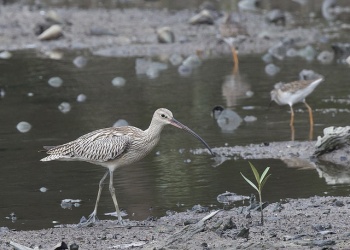(taxon, refs) |
(→External Links: New Video search created) |
||
| Line 43: | Line 43: | ||
==External Links== | ==External Links== | ||
{{GSearch|"Numenius arquata" {{!}} "Eurasian Curlew"}} | {{GSearch|"Numenius arquata" {{!}} "Eurasian Curlew"}} | ||
| − | + | <br /> | |
| − | {{ | + | {{VSearch|"Numenius arquata" {{!}} "Eurasian Curlew"}} |
{{GS-checked}} | {{GS-checked}} | ||
<br /> | <br /> | ||
Revision as of 20:59, 15 February 2023
- Numenius arquata
Identification
50-60cm (19¾-23½ in)
- Greyish-brown overall plumage
- White back
- Long curved bill
Distribution
A widespread and generally common bird in the Western Palearctic. Breeds in the British Isles (except east and south-east England), discontinuously from France east to Poland, throughout coastal and lowland Scandinavia, the Baltic States and across Russia between about 48 and 64 degrees N. Southern limits are the Pyrenees, Alps and the Black Sea.
Resident in Ireland, parts of coastal Britain, Brittany, coastal Netherlands and south-west Sweden. Elsewhere a summer visitor, present April-August.
In winter found in southern Iceland, throughout the British Isles and much of western and southern Europe, Turkey and North Africa. Has bred in Spain and occasionally does so elsewhere out of main range including very small numbers in Italy.
Vagrant north to Jan Mayen, Bear Island and south to Canaries, Azores and Cape Verde Islands.
Taxonomy
Subspecies
Three subspecies aer recognized1:
- N. a. arquata :
- Breeds British Isles to Ural Mountains; winters to north-western Africa and India
- N. a. suschkini:
- Breeds in western Russia (lower Volga Valley and Urals east to southwestern Siberia) and northern Kazakhstan; winters along coasts of sub-Saharan Africa and southwestern Asia)
- N. a. orientalis:
- Breeds from central Siberia east to northeastern China (central Heilongjiang); winters along coasts of eastern and southern Africa, Madagascar, and from the southern Caspian Sea south to the Persian Gulf and east through southern Asia to eastern China and southern Japan, south to the Philippines and Greater Sundas (Indonesia)
Habitat
Breeds in wet grassland and meadows, drier parts of marshes, farmland, heaths and moorland. In winter mainly coastal, on estuaries and sandy shores, saltmarshes, on coastal grasslands and to a lesser extent, on inland wetlands.
Behaviour
Diet
The diet includes small invertebrates, small crabs and earthworms.
Breeding
Their nest is a bare scrape. The 3-6 eggs are incubated for about a month.
They are monogamous and territorial.
Vocalisation
Call: curloo-oo.
References
- Clements, J. F., T. S. Schulenberg, M. J. Iliff, T. A. Fredericks, J. A. Gerbracht, D. Lepage, S. M. Billerman, B. L. Sullivan, and C. L. Wood. 2022. The eBird/Clements checklist of Birds of the World: v2022. Downloaded from https://www.birds.cornell.edu/clementschecklist/download/
- Gill, F, D Donsker, and P Rasmussen (Eds). 2022. IOC World Bird List (v 12.2) DRAFT. Doi 10.14344/IOC.ML.12.2. http://www.worldbirdnames.org/
- Handbook of the Birds of the World Alive (retrieved December 2018)
Recommended Citation
- BirdForum Opus contributors. (2025) Eurasian Curlew. In: BirdForum, the forum for wild birds and birding. Retrieved 9 May 2025 from https://www.birdforum.net/opus/Eurasian_Curlew
External Links
GSearch checked for 2020 platform.






